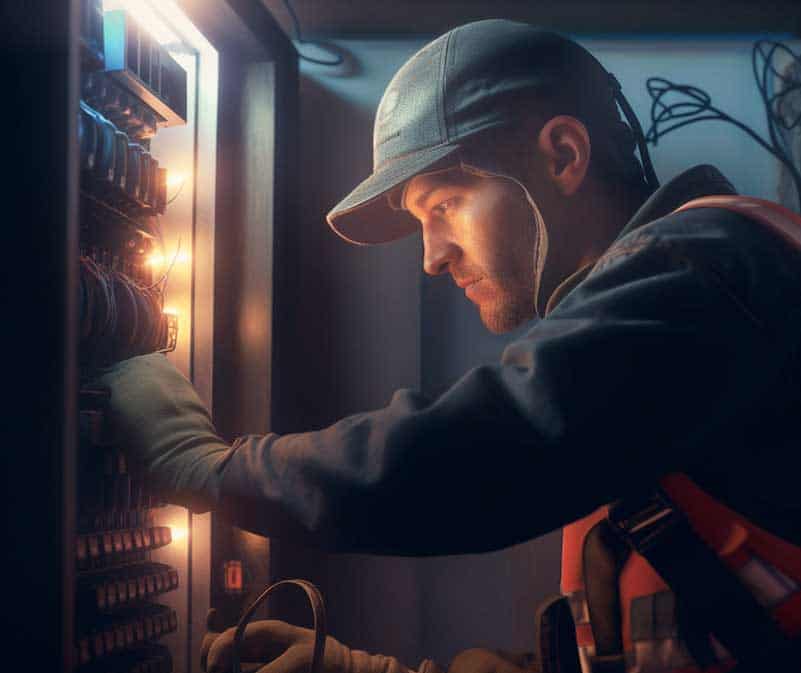Short circuits: How do professional electricians track them out?

You’ve got a short circuit: Now what?
You’re at home, enjoying good times when, suddenly, the power goes down. Your home is in total darkness. You look through the windows, and the neighborhood homes are fine. There’s no power outage in your area. Something is wrong with your own electricals.
Our advice would be, of course, to call a professional electrician because this is typically not a DIY job. What procedure would a professional follow to trace the short circuit? This it the topic of this article.
1. Safety first, always
Before starting our diagnostic process, we always prioritize safety. Here are some of the safety precautions our electricians take:
- Turning off the mains: We always turn off the main power supply to the panel before starting any diagnostic or repair work.
- Using insulated tools: We only use insulated tools to avoid accidental electrocution.
- Wearing protective gear: a professional electrician’s gear includes rubber gloves, safety goggles, and protective footwear. These items provide us with an added layer of protection against electrical shocks.
- Working in teams: We always have someone nearby when we work on electrical systems. When our electricians work alone on a job, they are always in contact with our office and account for their situation on a regular basis. This enables us to detect signs of trouble. If a technician receives an electrical shock, a colleague can assist or call 911 for help.
- Staying dry: We never work on electrical panels when the weather is bad or we risk standing in water. This is the reason why electricians and cable network technicians rarely come to your home when it’s raining.
2. Tools
Professional electricians always have in their truck all the tools they need to perform a diagnostic and repair issues. Homeowners rarely do. But those who do, have at least these instruments and tools:
- Multimeter: We use this instrument to measure voltage (V), resistance (R), and current (A).
- Insulated screwdrivers: As mentioned earlier, we need insulated tools to adjust or remove circuit components safely.
- Flashlight: Kind of self-evident.
- Inspection mirror: THis is very useful for seeing behind components or wires. In crammed spaces, it is a must.
- Circuit tracer: This instrument helps us identifying which circuit corresponds to which fuse.
3. Systematic Diagnostic Process of a Short Circuit
Step 1: Visually inspecting
We start with a visual inspection of your electrical panel. We look for any signs of burning, melting, or discoloration. These are 3 typical indicators of where the short circuit might have occurred.
- Burning: Indicates a direct exposure to excessive heat, often due to overloaded circuits or faulty wiring.
- Melting: Suggests prolonged exposure to high temperatures, which could be due to a malfunctioning component or a loose connection.
- Discoloration: Often a result of minor overheating over time, which can be due to age, wear, or external factors like exposure to sunlight.
Step 2: Identifying the affected circuits
Using a circuit tracer, we identify which circuits correspond to the triggered fuses. This narrows down the areas we will inspect.
A circuit tracer works by sending a signal through the circuit. A receiver detects the signal. By following this signal, we can trace the path of the circuit and identify its endpoints.
We first connect the transmitter to the circuit in question, usually at the breaker or fuse. Then we use the receiver to trace the path of the circuit throughout your home. As we move the receiver closer to the circuit, it emits a stronger signal, allowing use to identify the exact path and endpoints of the circuit.
Step 3: Checking for obvious signs
We inspect the wiring of the affected circuits. We look for any exposed wires, damaged insulation, and wires touching each other. These are common causes of short circuits.
What are the areas in a home where wiring commonly become faulty?
- Attics & basements: These areas are favorite locations for pests like rats or squirrels that can chew through wires.
- Older parts of your home: Your home may have been built in several sections at different times. In the oldest parts, aging wiring becomes brittle and cracks over time. Often, it is not even up to code and requires fully replacement anyways.
- Near water sources: In areas like bathrooms or kitchens, moisture corrodes wiring over time.
Step 4: Using a multimeter
We use a multimeter when the cause of the short circuit is not immediately apparent. This instrument measures resistance, indicating if there is a direct short in the circuit. We don’t use a multimeter before our visual inspection because we could just overlook fairly obvious issues.
We set the multimeter to measure resistance (ohms), disconnect the wire from the affected fuse, and measure its resistance to the ground. If it reads zero, we got a direct short.
Step 5: Isolating the issue
When we identify a potential short in a particular circuit, we disconnect devices or appliances connected to that circuit one by one. After that, we reset the fuse and see if it triggers again. This pinpoints if a specific device is causing the short.
Why can devices and appliances short a circuit?
- Faulty wiring: The internal wiring of the device is damaged or exposed. The inside of a washing machine, for instance, is very often corroded by exposure to constant humidity. In the region of San Antonio, the alternance of warm temperatures and cool periods creates problems over time with wiring and terminals.
- Overloading: The device draws more power than the circuit can handle. This is a scenario to which older homes are often facing: their electrical panel can’t handle the number and power requirements of electrical devices installed by the homeowners. When several devices and appliances operate at the same time, the power requirement become too high and the circuit trips.
- Worn-out components: Aging components within a device can malfunction, causing shorts. A common example of this issue is old electronic devices such as TVs and amplifiers. As component age, they stop meeting their factory specifications and can’t handle the current passing through them. Typically, they overheat.
Important warning
If you see smoke on the back of your TV or coming out of your stereo, immediately unplug the device, and monitor it to see if it stops emitting smoke. Electronic components have a degree of resilience to fire due to their density: they become overheated and start emitting smoke. But when they are not fed with electricity anymore, their temperature goes down and they may stop smoking altogether. That does not mean you can turn them back on safely. On the contrary, never turn back on a device once you see it starts emitting smoke: disconnect it, remove it from your home, and get a pro to repair it. If it’s not possible, throw it away by bringing it to a recycling station.
Step 6: Checking other components
Sometimes, the issue might not be with the wiring but with other electrical components like outlets, switches, or light fixtures. We inspect these components in the affected circuit for any signs of damage or wear.
- Outlets: Over time, the internal plastic and metallic components of an outlet wear out, creating loose connections. Additionally, outlets near water sources can corrode. This is typically the case of HVAC condensers for instance: the weather pickles their metal terminals, and corrosion prevents them from getting or releasing the power they need to operate normally.
- Switches: Similar to outlets, switches can wear out, especially when used frequently. Loose connections or damaged internal components often cause shorts.
- Light fixtures: Faulty wiring, damaged bulb sockets, or using bulbs with incorrect wattage can definitely cause short circuits.
Step 7: Non-electrical causes
There are other, non-electrical causes for short circuits. For example:
- Water leaks: A leak in a water pipe will create moist conditions around the leak. If moisture comes in contact with electrical components, you will have a short circuit.
- Settling of foundations: As homes age, their foundations settle. The resulting shifts can potentially damage embedded wiring. This is the case in the older ranch houses of the San Antonio area. Any house built before the 1950s will have experienced a degree of settling. The sheath of old cables and wires (like 20 years or so) is likely to have cracks. As a result, short circuits happen.
- Prolonged periods of very warm weather: In our region of San Antonio, heat is brutal. Extended heat periods cause expansion and contraction in electrical components (expansion during the day, contraction at night), loosening up connections and damaging wires.
- Prolonged periods of cold weather: Cold render plastic and rubber brittle. Over time, cracks appear in the electric sheath, and wires break.
Step 8: Finding faulty grounding
Faulty grounding leads to a host of electrical issues, short circuits being one of them. Proper grounding ensures that in the event of a fault, the excess electricity has a direct path to the earth. This prevents shocks and fires. But when the grounding is faulty, electricity seeks other paths, potentially causing shorts.
To check the grounding of a circuit, we use a circuit tester or our multimeter. We connect the tester to the ground wire and a known ground (like a metal water pipe). We can then determine if the circuit is properly grounded. If the tester lights up or the multimeter shows a reading close to zero, the grounding of the circuit is fine. If not… the grounding is very likely faulty.
We must address immediately faulty grounding. Fixing it is a job for a professional electrician. Not a DIY job.
Fixing a short circuit
As you can see, All Star Electric operates on a detailed protocol when isolating short circuits in a home. When we have identified a short, we typically repair it on the spot. If you see your breakers trip repeatedly, call All Star Electric at (210) 391-0274 to perform the inspection and the necessary repairs once you approve our estimate. We have been operating in San Antonio for almost 30 years, and our licensed professional electricians have the training and experience necessary to do a great job in your home. Our rates are reasonable, and we offer an outstanding warranty on our labor.






























